D3.2 - Inheritance
1/48
Earn XP
Description and Tags
IB Biology 2025 Syllabus Topic D2.3 - Inheritance. D3.2.1 - 15: SL / HL content D3.2.16 - 21: HL / AHL content only
Name | Mastery | Learn | Test | Matching | Spaced |
|---|
No study sessions yet.
49 Terms
D3.2.1 - Production of haploid gametes in parents and their fusion to form a diploid zygote as the means of inheritance
In meiosis, haploid gametes are produced. At fertilization, haploid gametes from the male and female fuse, restoring the diploid number of chromosomes.
A diploid cell has 2 copies of each autosomal gene.
This pattern of inheritance is common to all eukaryotes with a sexual life cycle.
D3.2.2 - Methods for conducting genetic crosses in flowering plants
Define ‘p generation’
P generation: The original pair of parents at the start of a genetic cross experiment
D3.2.2 - Methods for conducting genetic crosses in flowering plants
Define ‘F1 Generation’.
F1 Generation: The first generation that is produced by the p generation
D3.2.2 - Methods for conducting genetic crosses in flowering plants
Define ‘F2 Generation’.
F2 Generation: The result of a cross between two F1 individuals.
D3.2.2 - Methods for conducting genetic crosses in flowering plants
Define ‘Punnett grid’.
Punnet grid: a grid that shows the possible combinations of alleles that can result at fertilisation
D3.2.2 - Methods for conducting genetic crosses in flowering plants
Define ‘pollination’.
How do peas allow for self-pollination and self-fertilisation?
Pollination is the transfer of pollen grains (male gametes) from an anther to a stigma and then down to the ovules (female gametes).
Peas produce both male and female gametes on the same plant, allowing self pollination and therefore self fertilisation.
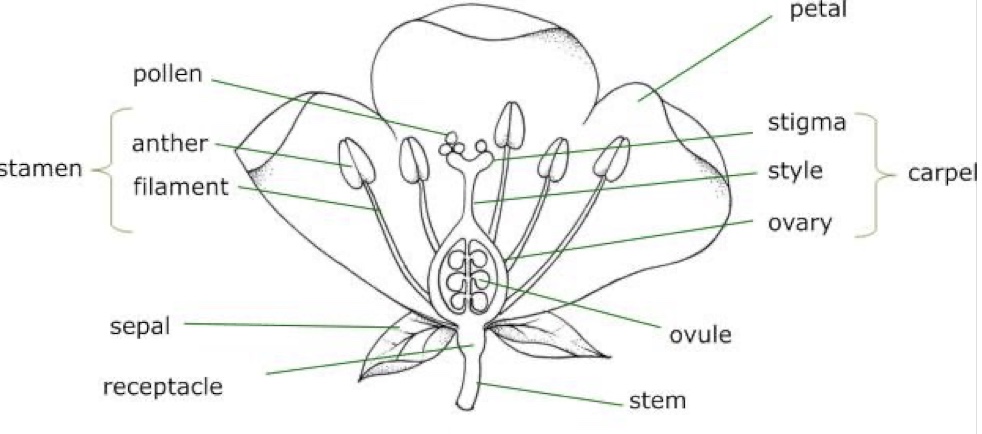
D3.2.2 - Methods for conducting genetic crosses in flowering plants
How are genetic crosses in flowering plants conducted?
Genetic crosses are widely used to breed new varieties of crop or ornamental plants.
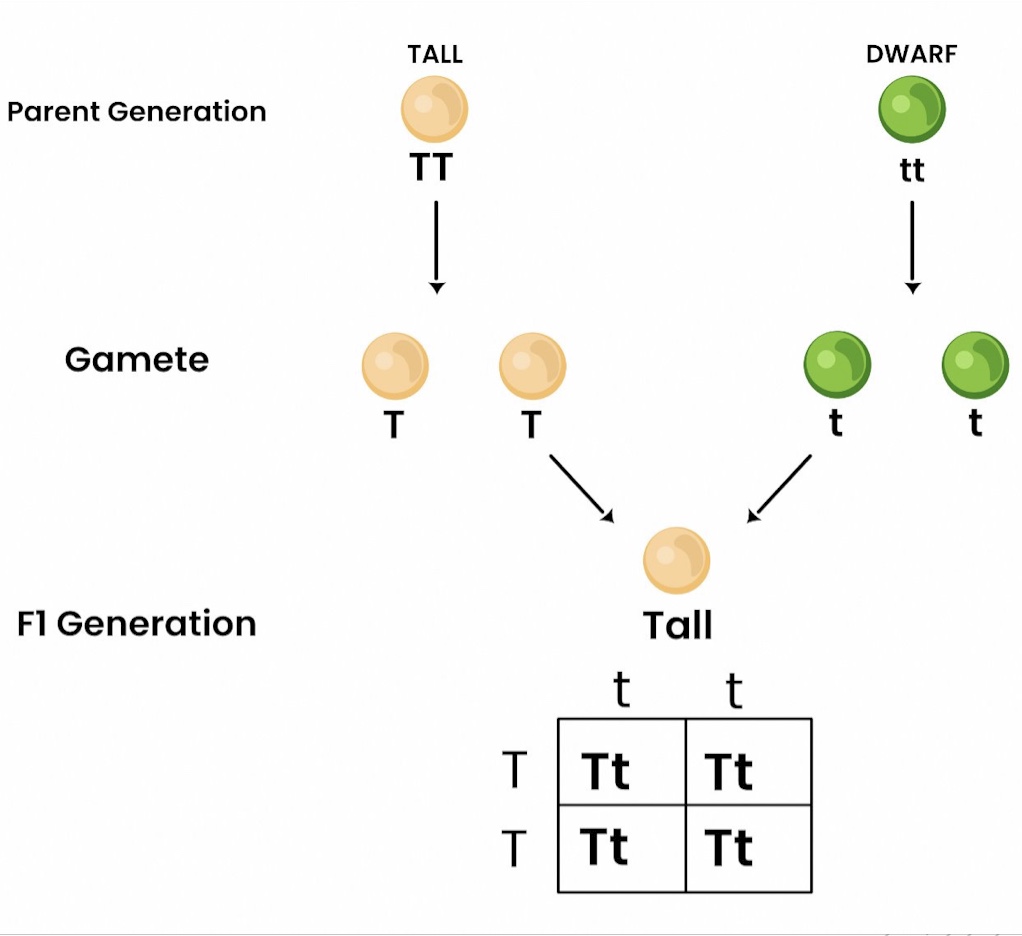
D3.2.3 - Genotype as the combination of alleles inherited by an organism
Define ‘homozygous’.
Homozygous - the maternal and paternal alleles are the same, the offspring is said to be homozygous for that gene
D3.2.3 - Genotype as the combination of alleles inherited by an organism
Define ‘heterozygous’
Heterozygous - if the maternal and paternal alleles are different, the offspring is said to be heterozygous for that gene
D3.2.3 - Genotype as the combination of alleles inherited by an organism
Define ‘gene’
Gene - a heritable factor that consists of a length of DNA and influences a specific characteristic
D3.2.3 - Genotype as the combination of alleles inherited by an organism
Define ‘alleles’
Alleles – different versions of the same gene.
D3.2.3 - Genotype as the combination of alleles inherited by an organism
Define ‘genotype’
Genotype - the gene composition (i.e. allele combination) for a specific trait is referred to as the genotype
D2.3.4 - Phenotype as the observable traits of an organism resulting from genotype and environmental factors
What are examples of phenotypes produced exclusively by genetics?
Phenotypes produced exclusively by genetics include:
ABO blood group
Genetic conditions ie Huntington’s disease, cystic fibrosis and colour blindness.
D2.3.4 - Phenotype as the observable traits of an organism resulting from genotype and environmental factors
What are examples of phenotypes produced exclusively by the environment?
Phenotypes produced exclusively by the environment include:
Learned behaviour ie birds learning a new song, humans learning maths
Acquired physical traits ie scars, large muscles
D2.3.4 - Phenotype as the observable traits of an organism resulting from genotype and environmental factors
What are examples of phenotypes produced by an interaction between genes and the environment?
Phenotypes produced by an interaction between genes and the environment include:
Height
Mass
D2.3.4 - Phenotype as the observable traits of an organism resulting from genotype and environmental factors
Define ‘phenotype’
Phenotype is determined by both the genotype and environmental influences and is the observable characteristics of a specific trait ie the physical expression. Sometimes organisms can have the same phenotype, but different genotypes.
D3.2.5 - Effects of dominant and recessive alleles on phenotypes
Define ‘dominant allele’
Dominant – an allele that has the same effect on the phenotype whether it is paired with the same allele or a different one. Dominant alleles are always expressed in the phenotype.
D3.2.5 - Effects of dominant and recessive alleles on phenotypes
Define ‘recessive allele’
Recessive – an allele that has an effect on the phenotype only when no dominant allele is present to mask it.
D2.3.6 - Phenotypic plasticity as the capacity to develop traits suited to the environment experienced by an organism, by varying patterns of gene expression
Define Phenotypic plasticity with some examples.
Phenotypic plasticity is an organism’s ability to express its phenotype differently depending on the environment. It is generated by varying patterns of gene expression. This is an effective way of adapting. It is not due to changes in the genotype and the changes in traits might reverse during the lifetime of the individual.
Examples:
Changes in morphology: results of exercise / diet
Changes in physiology: produce more or less of certain enzymes
Changes in behaviour: modify foraging depending on availability of food
D3.2.7 Phenylketonuria as an example of a human disease due to a recessive allele
Explain PKU - causes
Phenylketonuria (PKU) is a recessive genetic condition caused by mutation in an autosomal gene (PAH) on chromosome 12 that codes for the enzyme phenylalanine hydroxylase needed to convert the amino acid phenylalanine to a different amino acid, tyrosine. As phenylalanine hydroxylase is not synthesized, phenylalanine builds up in the body.
D3.2.7 Phenylketonuria as an example of a human disease due to a recessive allele
Treatment of Phenylketonuria?
Without treatment, most people with PKU develop severe brain damage.
To prevent this, treatment consists of a carefully controlled diet omitting food rich in phenylalanine ie eggs, chicken and nuts.
D3.2.7 Phenylketonuria as an example of a human disease due to a recessive allele
What are autosomal recessive diseases caused by?
Autosomal recessive diseases are caused by recessive alleles and the locus of their gene is found on one of the first 22 pairs of chromosomes, but not on the sex chromosomes.
D3.2.8 Single-nucleotide polymorphisms and multiple alleles in gene pools
What is an SNP? What can an individual inherit from a gene pool?
A single nucleotide polymorphism (SNP) represents a difference in a single nucleotide ie a different nitrogenous base and therefore this can create an alternative version of a gene (allele).
Many different versions of a gene can exist in a gene pool, but an individual can only inherit 2 alleles (one from each parent), rather than the full number of alleles available in a gene pool.
Most genes have more than 2 alleles and there are cases of genes with multiple alleles.
D3.2.9 ABO blood groups as an example of multiple alleles
Co-dominant alleles – both alleles are expressed within the phenotype.
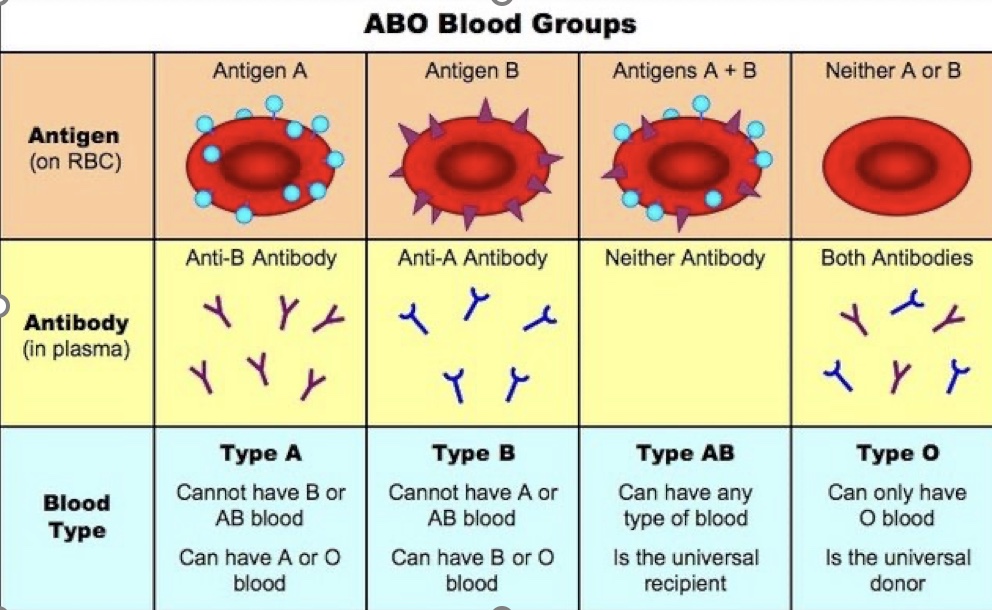
D3.2.9 ABO blood groups as an example of multiple alleles
Co-dominant alleles – both alleles are expressed within the phenotype.
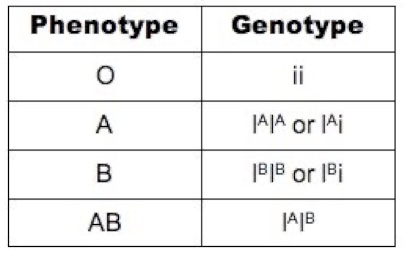
D3.2.10 Incomplete dominance and codominance
Define ‘Codominance’.
Codominance – heterozygotes have a dual phenotype.
D3.2.10 Incomplete dominance and codominance
Define ‘Incomplete dominance’. How does this show in Mirabilis julapa?
Incomplete dominance - neither is fully expressed in the phenotype, resulting in blending ie a new intermediate phenotype. In Mirabilis julapa, it has 2 pure breeding flowers; white and red. When crossed, they will show incomplete dominance by producing pink flowers.
D3.2.11 Sex determination in humans and inheritance of genes on sex chromosomes
How are chromosomes arranged?
The sex chromosome in the sperm determines whether a zygote develops a male or female physical characteristics. Far more genes are carried by the X chromosomes than on the Y chromosome.
D3.2.11 Sex determination in humans and inheritance of genes on sex chromosomes
How is the gender of a zygote determined?
The sex chromosome in the sperm determines whether a zygote develops a male or female physical characteristics.
Far more genes are carried by the X chromosomes than on the Y chromosome.
D3.2.12 Haemophilia as an example of a sex-linked genetic disorder
Haemophilia is a genetic disorder whereby the body’s ability to control blood clotting (and hence stop bleeding) is impaired.
The formation of a blood clot is controlled by a cascade of coagulation factors whose genes are located on the X chromosome.
When one of these factors becomes defective, fibrin formation is prevented - meaning bleeding continues for a long time.
Different forms of haemophilia can occur, based on which specific coagulation factor is mutated (e.g. haemophilia A = factor VIII.
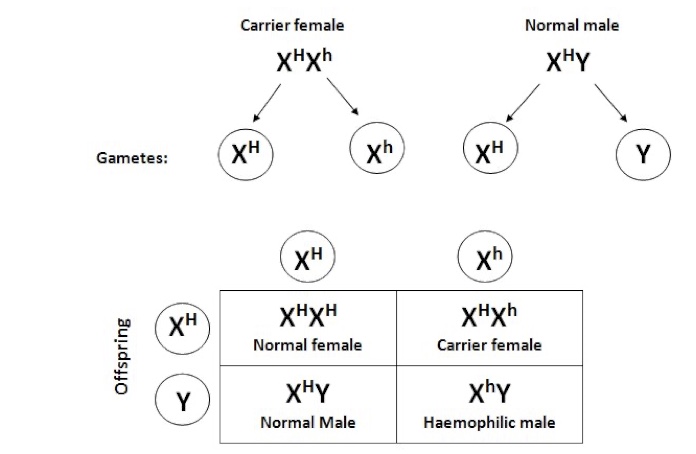
D3.2.12 Haemophilia as an example of a sex-linked genetic disorder
Define ‘carrier’
A carrier is a heterozygous individual with a recessive allele of a gene that does not have an effect on their phenotype ie they carry the allele but not express it.
D3.2.14 Continuous variation due to polygenic inheritance and/or environmental factors
Define ‘Discontinuous variation’.
Discontinuous variation: A type of variation usually controlled by a single gene, which leads to distinct classes (e.g. ABO blood group in humans).
D3.2.14 Continuous variation due to polygenic inheritance and/or environmental factors
Define ‘continuous variation’
Continuous variation: A type of variation controlled by many genes, which leads to a range of characteristics (e.g. skin pigmentation in humans).
D3.2.14 Continuous variation due to polygenic inheritance and/or environmental factors
Define ‘Mongenic traits’.
Monogenic traits (characteristics controlled by a single gene loci) tend to exhibit discrete variation, with individuals expressing one of a number of distinct phenotypes.
D3.2.14 Continuous variation due to polygenic inheritance and/or environmental factors
Define ‘Polygenic traits’ with an example.
Polygenic traits (characteristics controlled by more than two gene loci) tend to exhibit continuous variation, with an individual’s phenotype existing somewhere along a continuous spectrum of potential phenotypes.
An example of a polygenic trait that is influenced by environmental factors is human skin colour. Skin colour is controlled by multiple melanin producing genes, but is also affected by factors such as sun exposure
D3.2.15 Box-and-whisker plots to represent data for a continuous variable such as student height
A box-and-whisker plot is a statistical tool that can be used to visually represent the spread of population data.
The plot can show minimum, maximum and median values, as well as demonstrate the range via a lower and upper quartile. This allows researchers to easily assess how variable the data is and whether or not it is skewed in a particular direction.
The other benefit of a box-and-whisker plot is that it allows for the statistical determination of outliers. Outliers are any measurements that deviate by a significant margin from all other values (e.g. more than three standard deviations outside of the mean)
For a box-and-whisker plot, a data point is categorized as an outlier if it is either above the third quartile or below the first quartile by a value of more than 1.5 time the interquartile range (IQR)

D3.2.16 Segregation and independent assortment of unlinked genes in meiosis
What key events occur during meiotic division?
Key events that occur during meiotic division:
1. The law of segregation describes how homologous chromosomes (and hence allele pairs) are separated in meiosis I
2. The law of independent assortment describes how homologous pairs align randomly (as bivalents) during metaphase I
D3.2.16 Segregation and independent assortment of unlinked genes in meiosis
(Diagram)
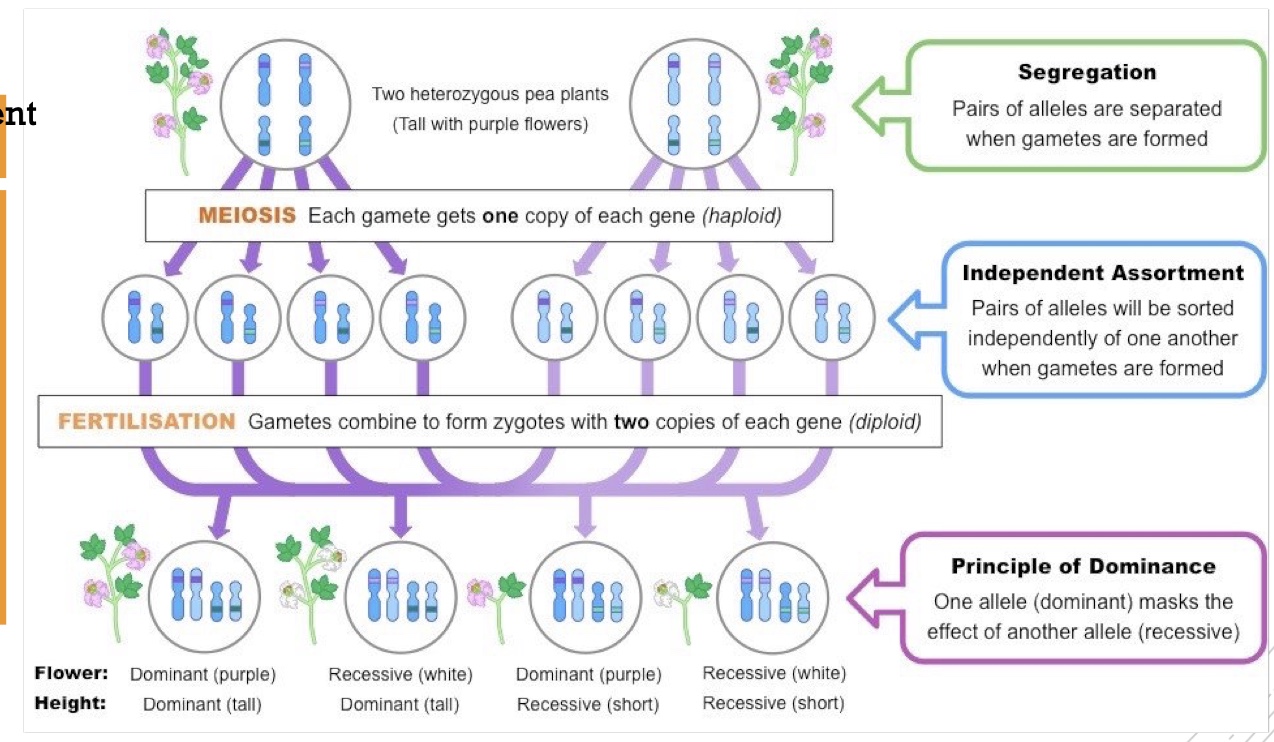
D3.2.17 Punnett grids for predicting genotypic and phenotypic ratios in dihybrid crosses involving pairs of unlinked autosomal genes
What ratios are based on Mendel’s second law and when does this law apply?
9:3:3:1 and 1:1:1:1 ratios are based on Mendel’s second law. This law only applies if genes are on different chromosomes or are far apart enough on 1 chromosome.
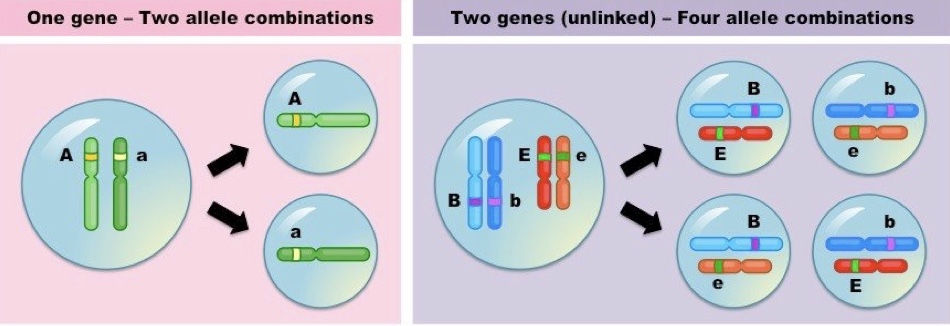
D3.2.17 Punnett grids for predicting genotypic and phenotypic ratios in dihybrid crosses involving pairs of unlinked autosomal genes
(Diagram)
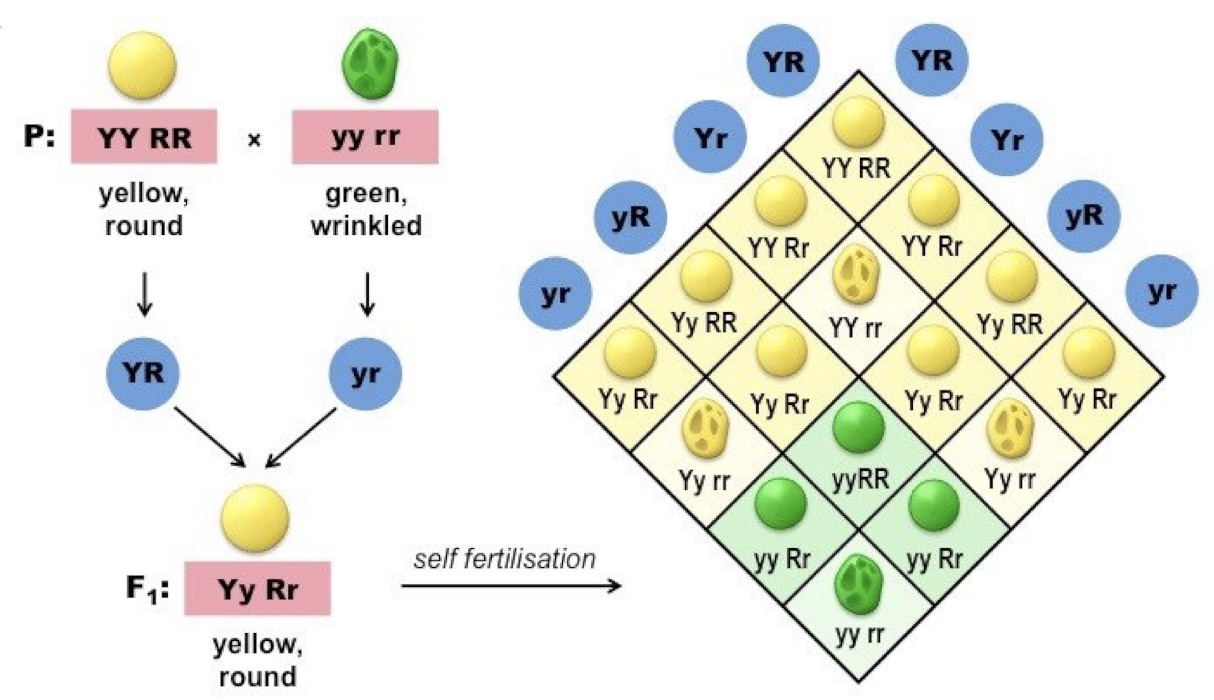
D3.2.18 Loci of human genes and their polypeptide products
Genes are located on chromosomes.
Each gene occupies a specific position on a chromosome and the gene for a particular characteristic is always found at the same position (locus) on a particular chromosome.
The locus of a gene is its specific position on one of 22 types of autosome (numbered 1-22) or one of the two types of sex chromosome (X and Y).
The genes code for the amino acid sequence of a polypeptide.
D3.2.19 Autosomal gene linkage
What is a linkage group?
A linkage group is a group of genes whose loci are on the same chromosome and hence don’t independently assort.
D3.2.19 Autosomal gene linkage
What is the phenotypic ratio more aligned to in the case of linked genes?
How can linked genes become separated?
Linked genes will tend to be inherited together and hence don’t follow normal Mendelian inheritance for a dihybrid cross. Instead the phenotypic ratio will be more closely aligned to a monohybrid cross as the two genes are inherited as a single unit.
Linked genes may become separated via recombination (due to crossing over during synapsis in meiosis I).
D3.2.19 Autosomal gene linkage
(Diagram)
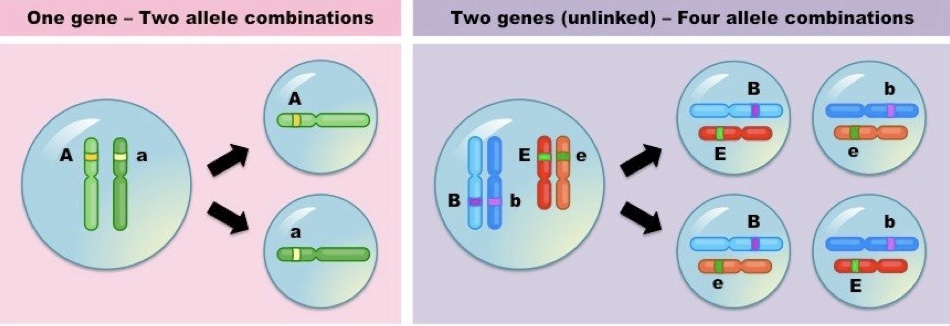
D3.2.19 Autosomal gene linkage
(Diagram 2)
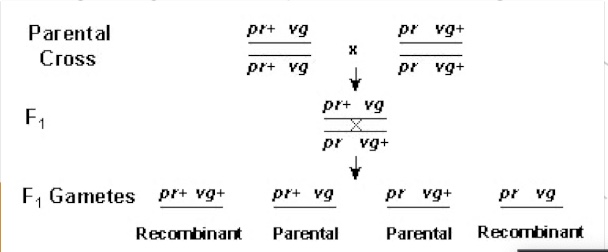
D3.2.20 Recombinants in crosses involving two linked or unlinked genes
What is recombination?
Recombination is a process by which pieces of DNA are broken and recombined to produce new combinations of alleles.
D3.2.20 Recombinants in crosses involving two linked or unlinked genes
(Diagram)
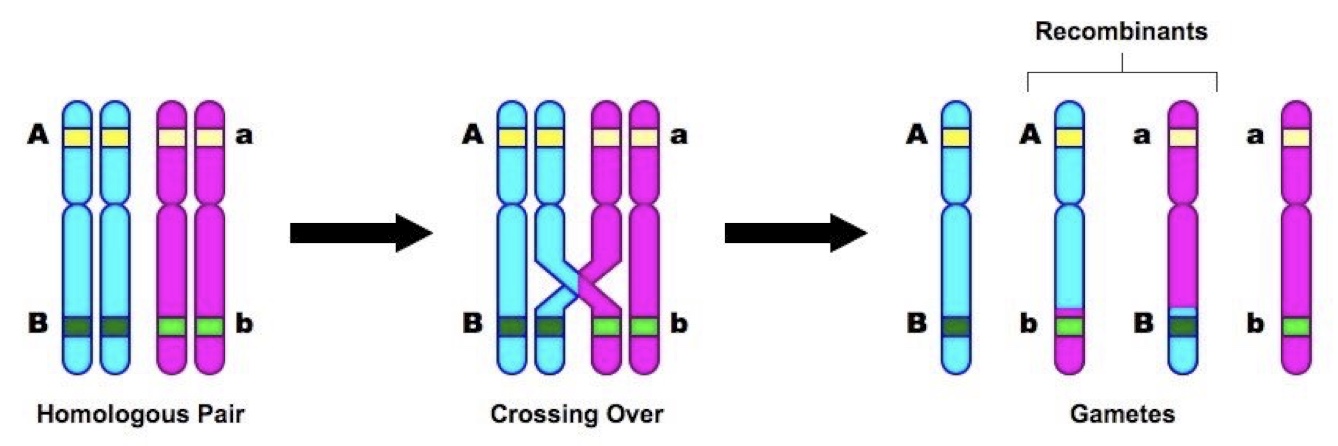
D3.2.21 Use of a chi-squared test on data from dihybrid crosses
Where would you apply a chi-squared test?
A chi-squared test can be applied to data generated from quadrat sampling to determine if there is a statistically significant association between the distribution of two species
D3.2.21 Use of a chi-squared test on data from dihybrid crosses
What are the 5 steps for completing a chi-squared test?
Identify hypotheses (null versus alternative)
Construct a table of frequencies (observed versus expected)
Apply the chi-squared formula
Determine the degree of freedom (df)
Identify the p value (should be <0.05)